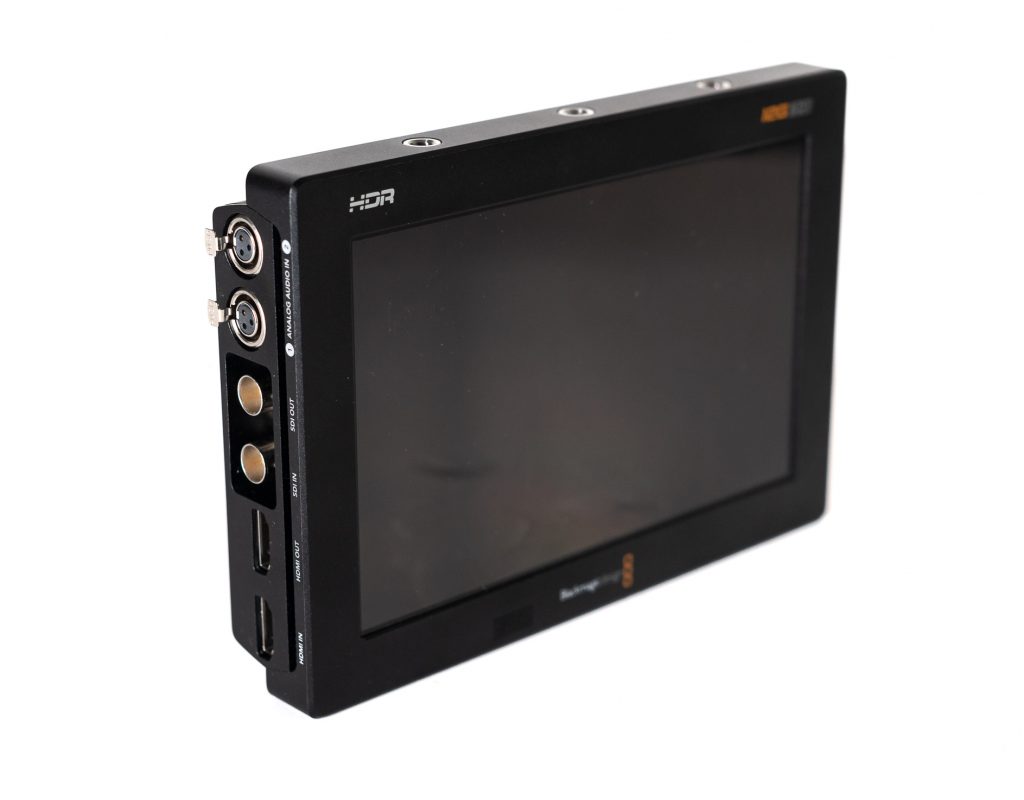The original Blackmagic Design 7-inch Video Assist 4K is one of my all-time favorite monitors/recorders. The main reason I like it so much? The Video Assist 4K can record from either an SDI or HDMI source to ProRes HQ in 10bit color. The only down-side of the original design was the screen brightness; it was in no way bright enough for day-light viewing. Now, Blackmagic Design has a whole new 12G Video Assist 7-inch and 5-inch 10bit color monitor/record with a much, much brighter screen.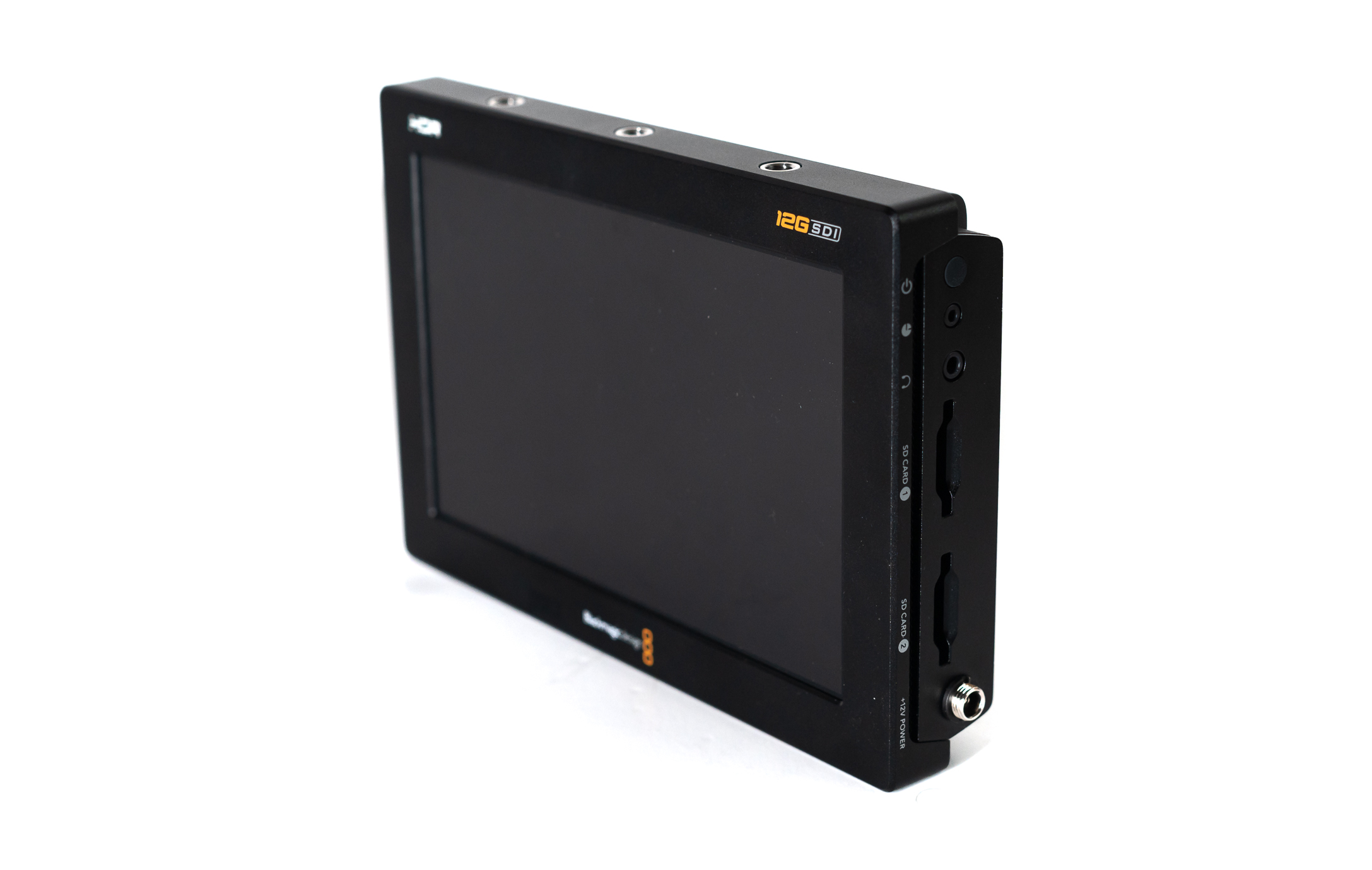
12G Video Assist Brightness
Damn, the Blackmagic Design 12G Video Assist is bright. First off, the brightness of the 12G Video Assist 7” is what piqued my interest in the monitor/recorder. If you have tried to use a monitor outside in bright sunlight, you understand frustration through the squintiest of eyes. A not-so-bright monitor can be headache-inducing and confidence crushing, for sure.
How bright is the Blackmagic Design 12G Video Assist? The monitor and recorder are bright enough for you to shoot with confidence under the bright sun without worry. The 2500nits of screen brightness is a significant jump over the previous model of Blackmagic Video Assist. Now, Nashville, Tennessee, does not have the sunniest of weather this season. I live in an area with LOG style weather throughout the winter months, which is not the best time to test screen brightness. Yet, we had a couple of bright sky days, giving me enough time to see the full 2500nits of brightness was way more than enough screen brightness to handle these situations. I think you could take the 12G Video Assist 7-inch into the high desert in expect to see your screen well.
HDMI Input
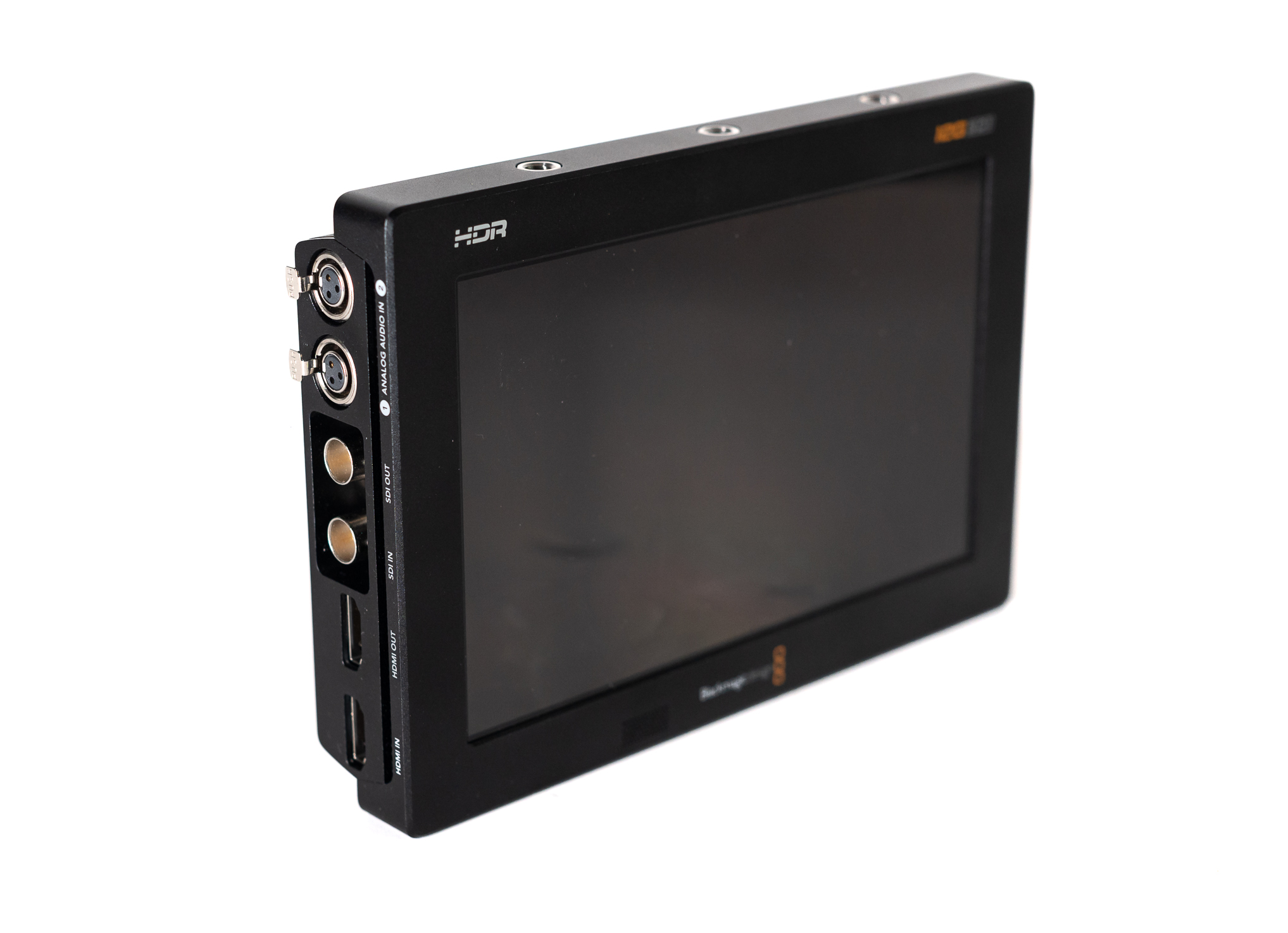 Since I started this review, Blackmagic Design released a new firmware update that is supposed to address issues of HDMI latency. I cannot say with all clarity if this firmware fixes the issue or not. I can address what I experienced with HDMI inputs and the previous firmware for the 12G Video Assist 7-inch, which had somewhere between a slight delay to a little uncomfortable delay to use the 12G Video Assist as an on-camera monitor for focus assist. This HDMI delay was not with all cameras.
Since I started this review, Blackmagic Design released a new firmware update that is supposed to address issues of HDMI latency. I cannot say with all clarity if this firmware fixes the issue or not. I can address what I experienced with HDMI inputs and the previous firmware for the 12G Video Assist 7-inch, which had somewhere between a slight delay to a little uncomfortable delay to use the 12G Video Assist as an on-camera monitor for focus assist. This HDMI delay was not with all cameras.
Where and how did I see the HDMI Latency? When using the 12G Video Assist 7-inch with my Nikon Z6. I asked Blackmagic Design to see if this was a camera issue or a 12G Video Assist issue. Blackmagic Design stated they believe it to be a camera issue. This delay could be from the camera, the Nikon Z6, or the HDMI cord itself. It would be best if you had HDMI cords capable of handling the beefier 10bit HD or 4K coming out of a camera to make sure there is no HDMI delay from the camera to the 12G Video Assist 7-inch.
SDI Input
This input for the 12G Video Assist was perfect. I experienced a zero delay with the SDI input from my Blackmagic Design URSA Mini Pro to the 12G Video Assist 7-inch monitor/recorder. I suggest if you have an SDI capable camera, to use the SDI because this input to the Video Assist was solid with a nearly absent delay. Plus, the likelihood of accidentally pulling a cord out of the input is far less with an SDI connection than an HDMI connection.
4K – HD / Input & Output
A question I received asked if the Blackmagic 12G Video Assist 7-inch or 5-inch monitor/recorder can take a 4K input, either HDMI or SDI, and record in HD instead of the 4K input. No, if you send 4K to the 12G Video Assist, then it automatically sets the recording resolution to 4K. If you send HD to the recorder, it automatically sets the recording resolution to HD.
If you send 4K to the 12G Video Assist input, then the monitor/recorder only outputs 4K. If you have an HD resolution input, then the output, in either SDI or HDMI, is set to HD resolution. You cannot send a 4K input and expect an HD output. What you send to the 12G Video Assist is what you receive in the output. 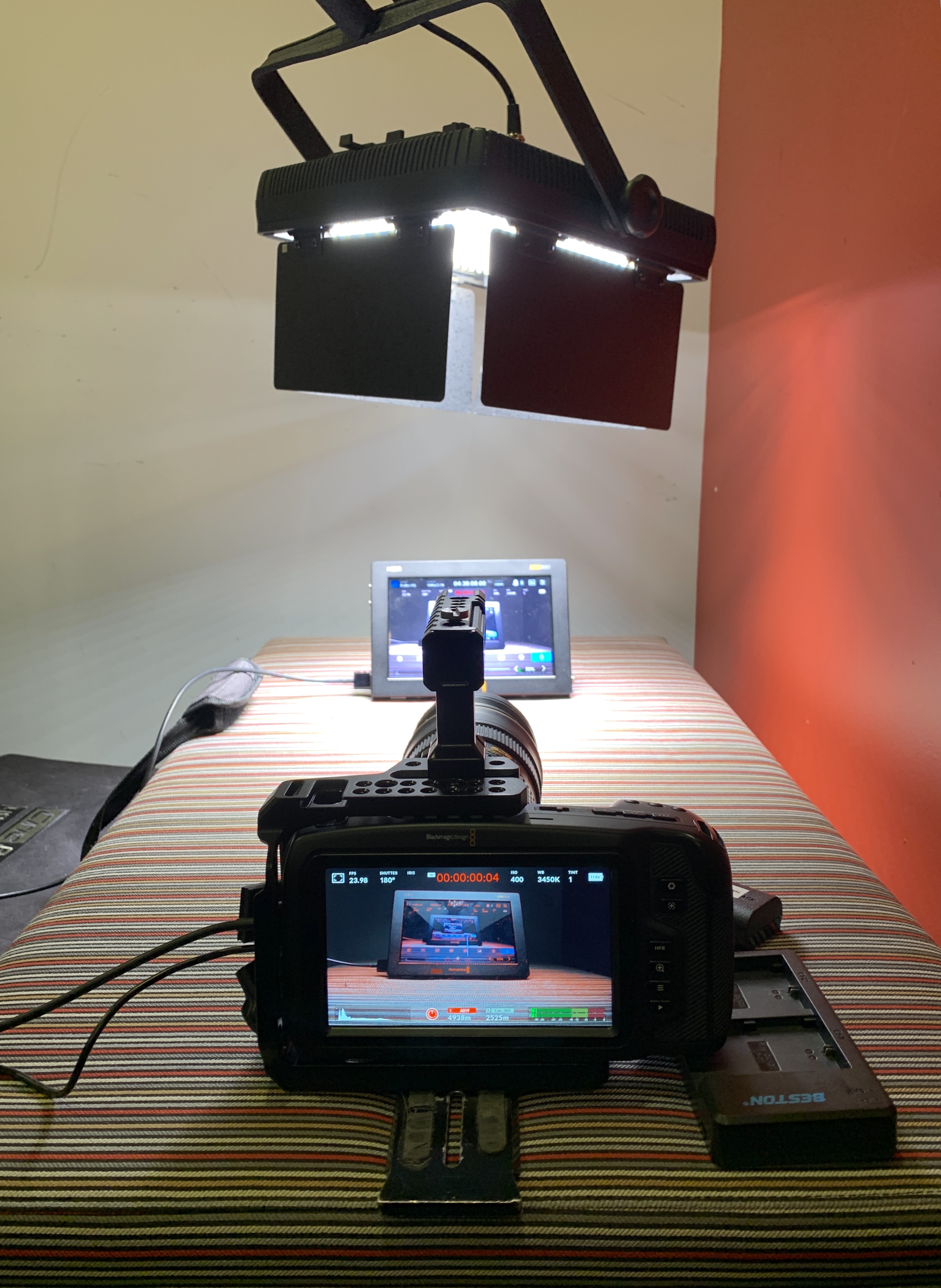
Battery Power
How long does the Blackmagic Design 12G Video Assist 7-inch last on battery power? It depends on the batteries you are using and your screen brightness settings. I did a little test with two Anton Bauer NP-F976 7.2V, 6600mAhg L-Series Li-Ion batteries. The length of time the batteries lasted with the 12G Video Assist set to 2500nits? A little past 2 hours as the monitor drained the last remnants of each battery. 2 hours is a good amount of time with a monitor set to 2500nits. I am impressed.
So Very Bright
I mentioned above I live in Nashville, Tennessee, and our weather in the winter is usually overcast and gray. When testing the screen brightness in this type of weather, I came across an interesting issue. None of this issue has anything to do with the actual Blackmagic Design 12G Video Assist 7-inch and everything to do with calibrating your monitor’s brightness levels for viewing. The screen brightness setting can be so bright one can make the mistake of not seeing how the camera’s actual exposure. There are exposure meters/scopes in the 12G Video Assist. Use the meters because the screen may be so bright to appear to have exposure set correctly, but in reality, you are shooting underexposed. I had this happen to me, and I can be dumb at times or in a rush, so watch out.
4 Video scopes
The 12G Video Assist 7-inch monitor also has video scopes to help you nail exposure and color. Waveform, parade, vectorscope, and a histogram all can be overlaid a video image or shown in white on a field of black. I wish these scopes were in color. It is just a little bit more helpful to have a parade scope showing the red, blue, and green, so a glance from a Director of Photographer can ensure all is right with her image. Bonus, The built-in scopes change to HDR scopes when working in HDR formats. That is kind of cool. 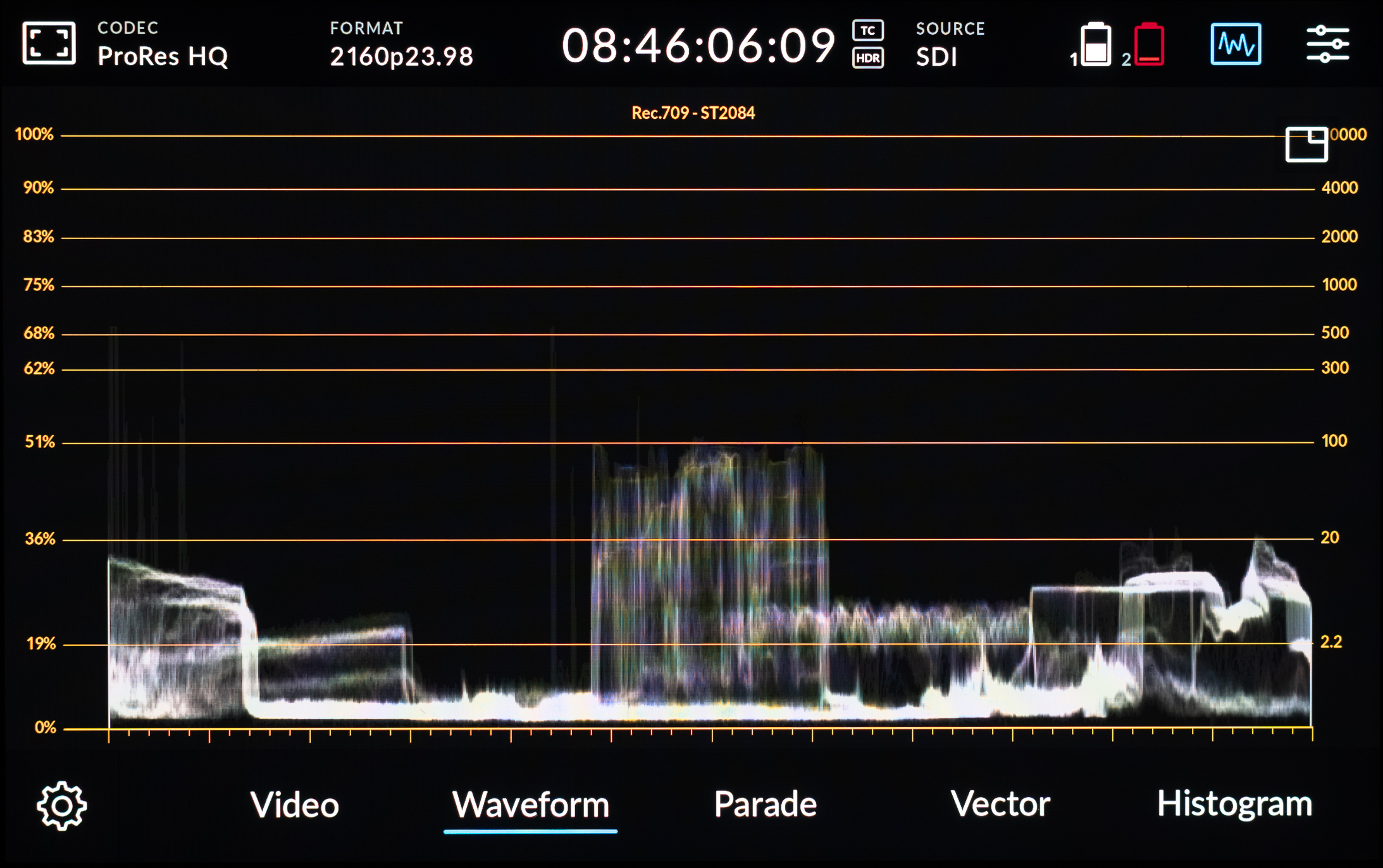
3D LUTs
Just like other Blackmagic Design cameras and the new 12G Video Assist 7-inch and 5-inch monitor/recorders, all allow users to load their own 3D LUTs. I use this feature pretty often to match one camera to another. It is beneficial, and exporting a 3D LUT out of DaVinci Resolve Studio is pretty straightforward.
HDR
Now, I saw this while reviewing the P3 Wide Color Gamut Blackmagic Design 12G Video Assist 7-inch, and I thought it was pretty cool, the monitor/recorder automatically recognizes the color space you send it. If you have the 12G Video Assist 12G attached to your camera and that camera has Rec2020 selected, then the monitor/recorder shows the Video Scopes in that selected color space. This auto-selected was a nice cool feature to save a camera operator from accidentally forgetting to select the correct color space on the 12G Video Assist, which I think could be easy to do.
Essentially, files have the correct HDR information, then SDI and HDMI inputs will also automatically detect HDR video standards. Static metadata PQ and HLG formats are handled according to the ST2084 standard. The bright LCD has a wider color gamut so it can handle both Rec. 2020 and Rec. 709 colorspaces. The built-in Video Assist LCD color gamut can even handle 100% of the DCI‑P3 format.
BlackmagicRAW
The firmware I tested in the Blackmagic Design 12G Video Assist 7-inch did not have the BlackmagicRAW setting available. I have, however, used BlackmagicRAW extensively. It is a lovely format that is easy for DaVinci Resolve to process on even my long-in-the-tooth MacBook Pro 2011. I believe this feature opens up a great, and easy to use, raw option to both the Panasonic EVA1 and Canon C300 Mark II. In the case of the Panasonic EVA1, the BlackmagicRAW resolution is the full 5.7K out of the camera. Please make sure you have SDI cables capable of this beefy output from either camera. This feature alone can help extend the life of your Canon C300 Mark II and Panasonic EVA1. In these times, uncertain as they are, extending the life of a camera and saving money is a great thing. Reminder, only SDI inputs support BlackmagicRAW recording.
- Blackmagic RAW Constant Bitrate 3:1
- Blackmagic RAW Constant Bitrate 5:1
- Blackmagic RAW Constant Bitrate 8:1
- Blackmagic RAW Constant Bitrate 12:1
- Blackmagic RAW Constant Quality Q0
- Blackmagic RAW Constant Quality Q5
USB-C recording
I am on the fence with the USB-C Recording in the Blackmagic Design 12G Video Assist 7-inch. Why am I on the fence about using the USB-C recording feature? I worry that the connection becomes damaged while on a shoot. A damaged USB-C connection may leave you without a recording option. Yet, the problem of using SD cards is a perception problem. Many people, who are not shooters, think SD Cards are inexpensive and hold on them instead of returning to me. It has happened to me enough to be a problem. I guess what I am saying is do what is best for you but keep backups options open. I go out with as much media as possible.
XLR Mini inputs
The Blackmagic Design 12G Video Assist 7-inch, and not the 5-inch, has XLR Mini inputs. The XLR Mini inputs allow for mirrorless shooters to have a more professional connection and audio options. I suggest making your own or having a place like Trew Audio build you the XLR Mini custom cables you need to be sleek and professional. I like using these inputs when I have a camera on a gimbal. In these situations, the 12G Video Assist is recording both audio and video, which allows me to have fewer cables or accessories attached to the camera on the gimbal tray. In SDI, you can record 16 channels of embedded audio. In HDMI, you can record 8 channels of embedded audio.
Weight
The 12G Video Assist 7-inch, with two Sony 970 L-series batteries, is on the heavy side. The weight of the monitor/recording, without batteries or media, is 29 ounces. Add two bigger batteries, and you are tipping the scales for a top-mounted camera monitor. On a Blackmagic Design URSA Mini Pro G2, the weight is not a huge deal. On a Nikon Z6, the weight of the 12G Video Assist to just too heavy for an easy to use camera rig. I think the 5-inch model may be best for most mirrorless cameras.
All in the P3 Wide Color Gamut Blackmagic Design 12G Video Assist 7-inch 10bit monitor/recorder is feature-rich. From useful video scopes to two different recording options, this Video Assist may give you plenty of use for years to come. While $995 is expensive, I think you have to remember this monitor may have a lifespan longer than your last camera purchase.
Key Features
- 7″ 1920 x 1200 Touchscreen LCD
- Record up to DCI or UHD 4K HDR Video
- HDMI and 12G-SDI Video Inputs & Outputs
- 10-Bit, 4:2:2 ProRes & DNxHD Encoding

Filmtools
Filmmakers go-to destination for pre-production, production & post production equipment!
Shop Now